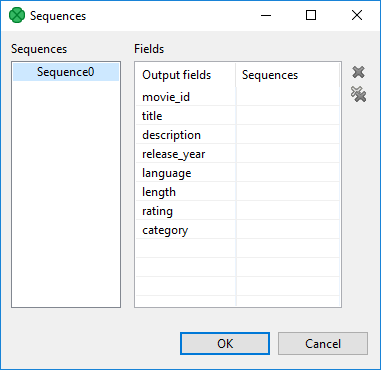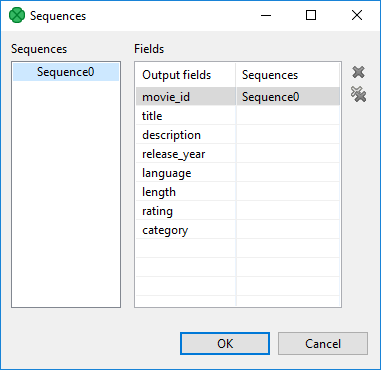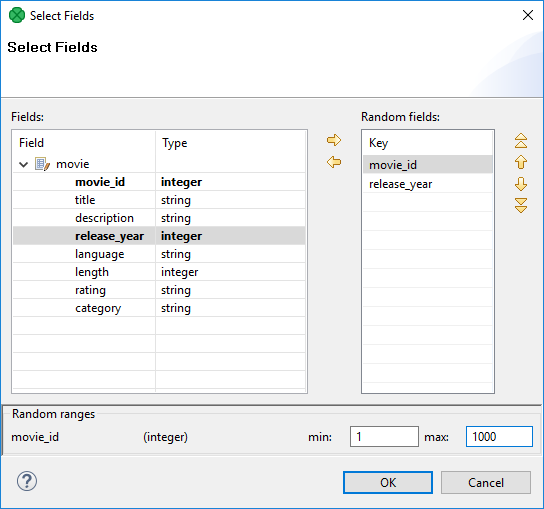
DataGenerator

Short Description
DataGenerator generates data records using transformation.
| Data source | Input ports | Output ports | Each to all outputs | Different to different outputs | Transformation | Transf. req. | Java | CTL | Auto-propagated metadata |
|---|---|---|---|---|---|---|---|---|---|
Generated |
0 |
1-N |
⨯ |
✓ |
✓ |
✓ |
✓ |
✓ |
⨯ |
Ports
| Port type | Number | Required | Description | Metadata |
|---|---|---|---|---|
Output |
0 |
✓ |
For generated data records |
Any |
1-N |
⨯ |
For generated data records |
Any |
The component can send different records to different output ports using Return Values of Transformations.
Metadata
DataGenerator does not propagate metadata.
Datagenerator has no metadata template.
Output metadata fields can have any data types.
Metadata on output ports can differ.
Metadata on all output ports can use Autofilling Functions.
DataGenerator Attributes
| Attribute | Req | Description | Possible values |
|---|---|---|---|
Basic |
|||
Generator |
Definition of the way how records should be generated; written in the graph in CTL or Java. |
||
Generator URL |
The name of an external file, including path, containing the definition of the way how records should be generated; written in CTL or Java. |
||
Generator class |
The name of an external class defining the way how records should be generated. |
||
Generator source charset |
Encoding of an external file defining the transformation. The default encoding depends on DEFAULT_SOURCE_CODE_CHARSET in defaultProperties. |
||
Number of records to generate |
yes |
Number of records to be generated. A negative number indicates that the number is unknown at design time. See Generating Variable Number of Records. |
|
Deprecated |
|||
Record pattern |
String consisting of all fields of generated records that are constant. It does not contain values of random or sequence fields. For more information, see Record Pattern. User should define random and sequence fields first. For more information, see Random Fields and Sequence Fields. |
||
Random fields |
Sequence of individual field ranges separated by a semicolon. Individual ranges are defined by their minimum and maximum values. Minimum value is included in the range, maximum value is excluded from the range. Numeric data types represent numbers generated at random that are greater than or equal to the minimum value and less than the maximum value. If they are defined by the same value for both minimum and maximum, these fields will equal to such specified value. Fields of string and byte data type are defined by specifying their minimum and maximum length.
For more information, see Random Fields.
Example of one individual field range: |
||
Sequence fields |
Fields generated by a sequence.
They are defined as a sequence of individual field mappings ( |
||
Random seed |
Sets the seed of this random number generator using a single Random seed influences field values generated using the Random fields attribute only.
It does not affect values generated using the Generator, Generator URL or Generator class attributes.
To set a random seed there, use the |
0-N |
|
Details
DataGenerator generates data according to a pattern instead of reading data from a file, database, or any other data source. To generate data, a generate transformation may be defined.
It uses a CTL template for DataGenerator or implements a RecordGenerate interface.
DataGenerator Deprecated Attributes
If you do not define any of these three attributes, you can instead define the fields which should be generated at random (Random fields) and by sequence (Sequence fields) and fields that are constant (Record pattern).
Record Pattern
Record pattern is a string containing all constant fields (all except random and sequential fields) of the generated records in the form of a delimited (with delimiters defined in metadata on the output port) or fixed length (with sizes defined in metadata on the output port) record.
Sequence Fields
Sequence fields can be defined in the dialog that opens after clicking the Sequence fields attribute. The Sequences dialog looks like this:

This dialog consists of two panes with all graph sequences on the left and all Clover fields (names of the fields in metadata) on the right. Choose the desired sequence on the left and drag and drop it to the right pane to the desired field.
The dialog contains two buttons on its right side. For canceling the selected assigned mapping or all assigned mappings.

|
Remember that it is not necessary (although possible) to assign the same sequence to different Clover fields. |
Random Fields
This attribute defines the values of all fields whose values are generated at random. For each of the fields you can define its range (i.e. minimum and maximum values). These values are of the corresponding data types according to metadata. You can assign random fields in the Edit key dialog that opens after clicking the Random fields attribute.

There are the Fields pane on the left, the Random fields on the right and the Random ranges pane at the bottom. In the last pane, you can specify the ranges of the selected random field. There you can type specific values. You can move fields between the Fields and Random fields panes as was described above - by clicking the Left arrow and Right arrow buttons.
CTL Interface
You can specify a transformation using CTL in Generator or Generator URL attributes.
This can be done using the Transformations tab of the Transform Editor. However, you may find that you are unable to specify more advanced transformations using the easiest approach. In such a case, use CTL scripting.
CTL Templates for DataGenerator
This transformation template is used only in DataGenerator.
Once you have written your transformation in CTL, you can also convert it to the Java language code by using a corresponding button at the upper right corner of the tab.
| CTL Template Functions | |
|---|---|
boolean init() |
|
Required |
No |
Description |
Initialize the component, setup the environment, global variables. |
Invocation |
Called before processing the first record. |
Returns |
|
integer generate() |
|
Required |
yes |
Input Parameters |
none |
Returns |
Integer numbers.
For detailed information, see Return Values of Transformations.
Note that when Generating Variable Number of Records, |
Invocation |
Called repeatedly for each output record |
Description |
Defines the structure and values of all fields of output record. If If any part of the The |
Example |
|
integer generateOnError(string errorMessage, string stackTrace) |
|
Required |
no |
Input Parameters |
|
|
|
Returns |
Integer numbers. For detailed information, see Return Values of Transformations. |
Invocation |
Called if |
Description |
Defines the structure and values of all fields of an output record. If any part of the The |
Example |
|
string getMessage() |
|
Required |
No |
Description |
Prints an error message specified and invoked by the user (called only when either |
Invocation |
Called in any time specified by the user. |
Returns |
|
void preExecute() |
|
Required |
No |
Input parameters |
None |
Returns |
|
Description |
May be used to allocate and initialize resources required by the generate.
All resources allocated within this function should be released by the |
Invocation |
Called during each graph run before the transformation is executed. |
void postExecute() |
|
Required |
No |
Input parameters |
None |
Returns |
|
Description |
Should be used to free any resources allocated within the |
Invocation |
Called during each graph run after the entire transformation is executed. |
Output records or fields
Output records or fields are accessible within the generate() and generateOnError() functions only.
|
All of the other CTL template functions do not allow to access outputs. Remember that if you do not hold these rules, NullPointerException will be thrown. |
Java Interface
The transformation implements methods of the RecordGenerate interface and inherits other common methods from the Transform interface.
See Common Java Interfaces.
You can use Public CloverDX API, too.
Following are the methods of RecordGenerate interface:
-
boolean init(Properties parameters, DataRecordMetadata[] targetMetadata)Initializes generate class/function. This method is called only once at the beginning of the generate process. Any object allocation/initialization should happen here.
-
int generate(DataRecord[] target)Performs generator of target records. This method is called as one step in generate flow of records.
This method allows to distribute different records to different connected output ports according to the value returned for them. For more information about return values and their meaning, see Return Values of Transformations.
-
int generateOnError(Exception exception, DataRecord[] target)Performs generator of target records. This method is called as one step in generate flow of records. Called only if
generate(DataRecord[])throws an exception. -
void signal(Object signalObject)Method which can be used for signaling into generator that something outside has happened.
-
Object getSemiResult()Method which can be used for getting intermediate results out of generation. May or may not be implemented.
Examples
Generating Variable Number of Records
Sometimes the number of records to be generated is not known at design time.
In such a case, set the value of the Number of records to generate attribute to a negative number.
The component will then generate records until the generate() function returns STOP (in this case, it is not considered an error). This works for transformations defined both in Java and CTL.
|
Note that in the last iteration when |
integer total = randomInteger(1, 100);
integer counter = 0;
// Generates output record.
function integer generate() {
counter++;
if (counter > total) {
printLog(info, "Terminating");
return STOP;
}
if ((counter % 10) == 0) {
printLog(info, "Skipping record # " + counter);
return SKIP;
}
$out.0.value = "Record # " + counter;
return OK;
}Generating Random Values with Fixed Random Seed
Sometimes you need to generate random values in a graph and it should be possible to rerun it again returning the same values. This might be useful, for example, for tests.
The solution is to set the random seed for random number generator to some fixed value.
function boolean init() {
setRandomSeed(1231056256);
return true;
}
function integer generate() {
$out.0.value = randomInteger(0,199);
return OK;
}Best Practices
If Generator URL is used, we recommend users to explicitly specify Generator source charset.
